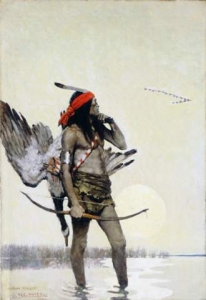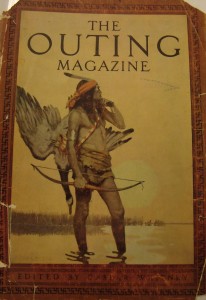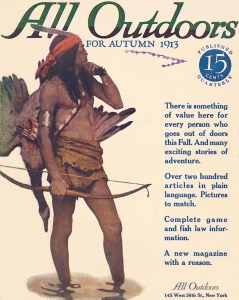
N. C. Wyeth (1882-1945)|The Hunter, 1906|Cover illustration intended for McClure’s Magazine, but used as cover illustration for The Outing Magazine, vol. L, no. 3 (June 1907); and again as cover illustration for All Outdoors Magazine (Autumn 1913)|Oil on canvas|Brandywine River Museum, Gift of Margaret K. Blodgett, 1972, BRM 72.10
Some illustrations may have more than one use. As you can see from the above information for Wyeth’s illustration of The Hunter, it was not used for its original intended purpose, but was published as a cover image the following year by different periodical and again a few years later for a third magazine. What I find most interesting is that in its final use as a cover the image was lifted out of most of its painted background–as though the Indian is displaced from his land, which of course by 1913 was indeed the case. That said, this implied meaning was probably not intended by the art editor of All Outdoors Magazine.
So how did Wyeth’s cover illustration go from McClure’s to All Outdoors? From 1902 through the summer of 1907, N. C. Wyeth studied the art of illustration with master illustrator and teacher Howard Pyle in Wilmington, Delaware.* Pyle urged his students to paint from first-hand experience, he also encouraged them to seek experiences that would support the kinds of images they hoped to paint. In 1904 Pyle proposed that Wyeth take a month-long trip in the American west. Wyeth negotiated with Scribner’s magazine to pay his travel expenses, in exchange for first refusal rights to the pictures made from the expedition. Even before his artistic studies with Pyle, Wyeth studied and indexed his favorite western images by Frederic Remington published in the popular press.** According to Wyeth, the West had “. . . never been painted except by Remington and he . . . only pictured the brutal and gory side of it and not the sublime and mysterious quality of those limitless plains and their heros.”*** There were other American artists who created mythic images of our country’s native population. For example, George de Forest Brush (1855-1941) wrote and illustrated an article on the visual richness of this population in an 1885 issue of Century Magazine in which he tells of his motivation for making such images. “. . . in choosing Indians as subjects for art, I do not paint from the historian’s or the antiquary’s point of view; . . . I am interested in those habits and deeds in which we have feelings in common.”****
Wyeth’s first western sojourn included time with cow punchers in Colorado, and sketching trips to Navajo reservations in Arizona and in New Mexico. Through 1906 Wyeth made two more trips out west, gathering images and experiences he would later translate into illustrations. As noted, this illustration was commissioned to be used as a cover illustration for McClure’s by Pyle early on during Pyle tenure as the art editor for the magazine. In the spring of 1906, Pyle added to his teaching and illustrating responsibilities the position of art editor for this New York publication. Pyle probably sought this additional employment in an attempt to broadening his earnings base while at the same time to providing work for his better students; but Pyle’s tenure at McClure’s was fraught with difficulties and he resigned from the magazine before the end of that summer.
Without Pyle’s handing out commissions and the magazine’s concurrent financial difficulties, a variety of Pyle’s student’s commissions fell through. This intended cover image was one of the victims. Painted in August 1906, it had the monthly’s masthead, McClure’s Magazine, painted at the top.***** When the cover image was not used by McClure’s, Wyeth painted over the magazine’s name. The following year Wyeth included it in his offering to The Outing Magazine as part of a series called, “The Indian in His Solitude.” This image of The Hunter was then used as the cover illustration for Outing’s June 1907 issue.

N. C. Wyeth also sold the reproduction rights for this and the other “Solitude” paintings to Outing Magazine who in turn offered a variety reproductions to these illustrations in their magazine. The illustration was used once more as a cover for the Autumn 1913 issue of the All Outdoors Magazine.

The comparison of the original painting to the Outing cover is interesting. All of the same elements are visible in the two versions. Only the background color and over all tone of the image is different. When the image was used for All Outdoors the only bit of the background still visible is the skein of geese flying in V-formation in the sky.****** The body water in which The Hunter stands is reduced to merely a notation of his shadow darkening the surface ripples. This diminution of the image to its basic elements was probably not Wyeth’s choice, but that of the magazine’s art editor.
* Pyle opened his school of illustration art in the fall of 1900. Sometimes this school is referred to as the Brandywine School of Art. While it is true that through the years Pyle taught illustration art first at Drexel in Philadelphia and later at his own school in Wilmington, that he often took his best students out to continue their studies during the summer on his family’s property in Chadds Ford, Pennsylvania near the Brandywine River, his school was called the Howard Pyle School of Art.
** David Michaelis, N. C. Wyeth: A Biography (New York: Alfred A. Knopf, 1998): 32.
*** Michaelis, Wyeth : 113.
**** George de Forest Brush, “An Artist Among the Indians” Century Magazine v. 30 # 1 (May 1885): 54-57.
***** Christine B. Podmaniczky, N. C. Wyeth, A Catalogue Raisonné of Paintings (London: Scala, 2008): I.151; 152.
****** A gaggle of geese is a flock of more than five that is not flying; a skein of geese is the flock in flight.
January 13, 2011
By Joyce K. Schiller, Curator, Rockwell Center for American Visual Studies
Norman Rockwell Museum






